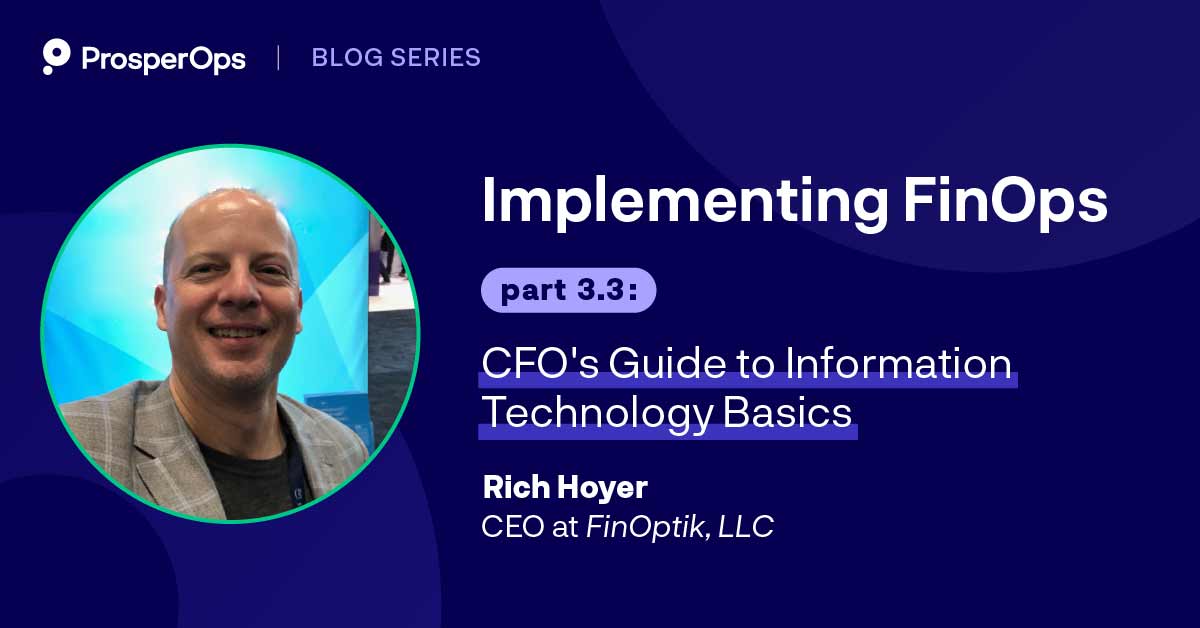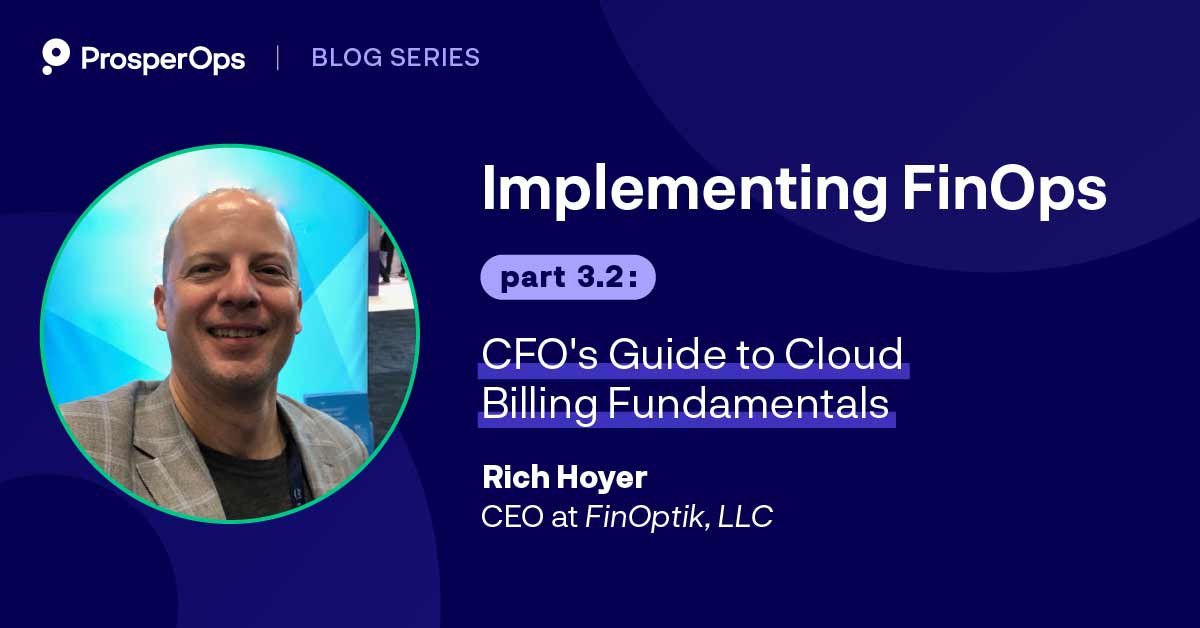Choosing the right RDS instance type is key to optimizing Amazon Web Services (AWS) performance and cost. But with so many options, it’s easy to feel overwhelmed.
This article guides you through the intricacies of RDS instance types, offering clear, actionable strategies to select the best fit for your needs. We’ll show you how to match instance types to your specific workload requirements, ensuring you get the most bang for your buck.
We’ll also reveal how ProsperOps can streamline this process, making your AWS cost allocation smoother and more effective.
What does an Amazon RDS Instance do?
Amazon Relational Database Service (RDS) is your managed service for relational databases in the cloud, making life easier when you need database solutions.
Think of an RDS database (DB) instance as a self-contained database environment, finely tuned to run popular databases like MySQL and PostgreSQL.
RDS differs from EC2 Instances in a couple of important ways:
- RDS is a specialized service for relational database management with managed features
- EC2 provides more general-purpose, flexible virtual servers that require manual management but offer greater control.
When you choose an RDS DB instance, you’re picking from a menu of instance types.
Each of these types works for specific needs—general purpose, like T2 or T3, or memory-optimized, such as R5 or R6g, which feature AWS Graviton2 processors.
Instance types and sizes affect your CPU performance, including how many CPU cores you get, memory, storage type, and the instance’s throughput and IOPS.
What you use depends on your workload requirements:
- General-purpose workloads: Allow you to opt for general-purpose SSDs, which are a balance of performance and cost.
- High-performance needs: Choose provisioned IOPS (SSD) to achieve fast, predictable latency and high IOPS.
- Optimizations and bursts: Use burstable-performance instances (like T3 and T2) to burst above the baseline as needed and optimize your CPU utilization and memory resources so you can focus more on development and less on the underlying hardware.
- Read-heavy workloads: Utilize instances like R5 to access data faster.
RDS instances even manage your database with automated backups, software patching, and version upgrades.
Let’s dive into these RDS instance types in more detail.
General purpose instances
When you’re looking for a reliable and versatile RDS database solution, AWS designed general-purpose instances, like T2 and T3 instances, to meet the needs of a broad range of applications.
Offering a harmonious balance of CPU, memory, and storage, these instances optimize general-purpose workloads without biasing towards either compute or memory intensity.
Use cases
MySQL and PostgreSQL databases can thrive on general-purpose instances, given their all-around capabilities.
Whether you’re managing a web application backend, a customer relationship management system, or multi-purpose enterprise software, these instances can provide the necessary performance.
They are especially beneficial when you expect variable CPU utilization but don’t need the intensive computing power of specialized instances.
Benefits include:
- Flexible performance: Capable of handling fluctuations in workload with ease.
- Cost-effectiveness: Only use and pay for the resources you need.
- Scalability: Smoothly scale resources as your application demand grows.
Databases hosted on general-purpose instances have the advantage of using different storage types that support your data management and accessibility requirements.
If your workload involves a mix of read-and-write operations without dramatic peaks, these instances offer a solution that can grow alongside your business needs without overcomplicating your infrastructure.
By choosing general-purpose instances, you’re opting for an adaptable environment that closely aligns with the varying demands of everyday business tasks.
This approach helps ensure your applications and services run effectively, providing a seamless experience for users without incurring unnecessary costs for unused resources.
Memory-optimized instances
Memory-optimized instances in Amazon RDS handle large, memory-intensive workloads with ease. They use speedy processors and offer significant memory capacity, ensuring smooth operation for high-demand applications.
Use cases
AWS designed memory-optimized instances for scenarios where memory plays a pivotal role.
For example, your high-performance databases, both relational and NoSQL, will benefit from the ample memory these instances provide.
In particular, Amazon designed the R5 instances for this, offering a balance of compute and memory resources with up to 768 GiB of memory for demanding operations.
Similarly, AWS Graviton2 processors power the R6g instances, delivering enhanced performance for your in-memory databases and real-time big data analytics and providing a robust and cost-efficient solution for applications needing to process massive datasets swiftly.
| Instance Type | Processor | Ideal for |
| R5 | Intel Xeon® Platinum | High-performance databases |
| R6g | AWS Graviton2 | In-memory databases, Big data analytics |
By opting for memory-optimized instances, you’re choosing a path that’s tailor-made for handling large-scale, memory-hungry tasks efficiently.
In turn, you’ll ensure your data-driven applications perform optimally without a hitch.
Burstable performance instances
In Amazon Web Services (AWS), burstable performance instances provide a scalable CPU performance that adapts to your workload.
AWS designed them to deliver a baseline level of CPU performance with the flexibility to surge above the baseline when you need intense bursts of work.
Use cases
The ideal use case for burstable performance is when you run applications with variable CPU usage that’s usually lower but occasionally needs bursts of higher CPU performance.
These instances accumulate credits when running below their CPU baseline, which you can spend in periods of higher activity.
For instance, small to medium databases, low-latency interactive applications, and development environments can benefit. This is due to their irregular usage pattern that doesn’t need full CPU usage at all times but occasionally requires the ability to burst to deal with higher workloads.
The Amazon EC2 burstable instances like T4g and T3a also offer a balance between cost and performance for applications with similar characteristics.
Optimized Reads instances
Optimized Reads instances in Amazon RDS can significantly enhance your query performance. They provide low latency and high throughput, which ensures your read-heavy workloads perform efficiently.
Use cases
Why might you choose Optimized Reads instances?
Consider scenarios where your applications demand frequent and fast read operations from the database. Here’s what you should know:
- Throughput: AWS meticulously engineered these instances to offer dedicated throughput between Amazon RDS and Amazon EBS. This means you get a specific amount of data transfer per second, preventing bottlenecks and maintaining swift data flow.
- IOPS (Input/Output Operations Per Second): High IOPS counts are a signature feature of such instances, ensuring that even with data-intensive applications, your database can handle a significant load of read operations without breaking a sweat.
- Latency: Any delay between a request and its corresponding action in the database, referred to as latency, is minimal (crucial for applications where timing is critical).
- Instance types: You can optimize a diverse range of instances for different needs, from temporary block storage to high memory capacity. Choose an instance type that aligns with your specific requirements.
- Read-heavy workloads: If your use case involves read-heavy operations, like reporting or data analytics, where quick data retrieval is crucial, Optimized Reads instances can prove invaluable.
Choosing the right instance will hinge on understanding your workload, so look beyond the capacity. Factor in throughput and latency to ensure your database keeps pace with your business’s growth and speed demands.
Factors to consider when choosing an RDS instance type
Selecting the right RDS instance type is critical for your database’s efficiency and cost-effectiveness. You need to understand your application requirements and align them with the capabilities of various instance types.
Here are some factors to consider:
Nature of workload
Your application’s workload characteristics, such as CPU, memory, I/O, and network traffic demands, play a pivotal role in determining the suitable DB instance class.
For read-heavy traffic, a memory-optimized instance might be necessary, while compute-optimized instances better serve a compute-intensive workload.
Database size and performance requirements
Analyzing your database’s size alongside its performance needs help in identifying the right database instance type. Performance is closely tied to the DB instance classes, which range from small to extra-large configurations, directly affecting throughput and latency.
Cost considerations
Amazon RDS pricing is structured such that you pay for the resources you consume.
Balancing cost and performance involves selecting an instance type that delivers the necessary resources without over-provisioning. Reviewing pricing regularly and adjusting your use can also lead to cost savings.
Scalability and flexibility
The ability to scale is central to AWS services. Consider whether the instance types you’re evaluating can scale vertically by adding more CPU or memory and horizontally by adding more instances.
This scalability is crucial for adapting to changing demands without redesigning your infrastructure.
Availability and reliability
Your database should remain available and reliable, even during outages.
Choosing an instance that supports deployment in multiple availability zones enhances fault tolerance. Amazon RDS offers several features that help maintain availability, such as automated backups and multi-AZ deployments, ensuring continuity and data integrity.
How to choose the right RDS instance type
Choosing the right Amazon RDS instance type can significantly optimize both the performance and the cost-effectiveness of your database workloads. It also helps you choose the right cost-saving strategy for AWS.
Key factors such as workload requirements, database types like Oracle or Microsoft SQL Server, and storage options, including general-purpose SSD and magnetic, influence the decision.
Here are four tips to help you choose:
Analyze your application requirements
Firstly, assess your application’s specific needs. If your application relies heavily on database reads and writes, an RDS instance like the M5 or M6g optimized for compute capacity might be your best option.
For applications using MySQL, MariaDB, or Amazon Aurora, ensure the instance class supports your database engine of choice.
Consider cost and performance trade-offs
Balancing cost with performance is crucial.
General-purpose SSD storage offers a baseline performance level at a lower cost compared to provisioned IOPS SSD, which is costlier but provides faster, more consistent I/O.
This trade-off must align with your budget and performance requirements.
Plan for scalability and flexibility
Anticipate future growth and select an instance type that can scale, such as the M6g class.
MariaDB and Oracle databases, for instance, may require different resource allocations as demand changes. A flexible instance can adapt to fluctuating demands without overprovisioning and incurring unnecessary costs.
Test, monitor, and optimize
After choosing an instance, monitor its performance with AWS tools.
Use metrics to decide whether the chosen instance size is adequate for your specific workload.
Make sure you adapt and resize your instances as needed to maintain optimum performance and cost efficiency.
Optimizing your RDS costs with ProsperOps
Understanding the various AWS RDS instance types and their respective benefits is crucial for optimizing your AWS infrastructure. ProsperOps stands out in this landscape with its Autonomous Discount Management for RDS.
By batching and distributing Reserved Instances over time, ProsperOps maximizes cost efficiency, a benefit particularly valuable as RDS Reserved Instances cannot be sold or exchanged. This approach ensures you’re not just choosing the right RDS instance but also managing it cost-effectively.
Check out our blog post for deeper insights into RDS cost optimization support, and take the first step in improving cost efficiency with RDS instances by scheduling a demo with ProsperOps today.




